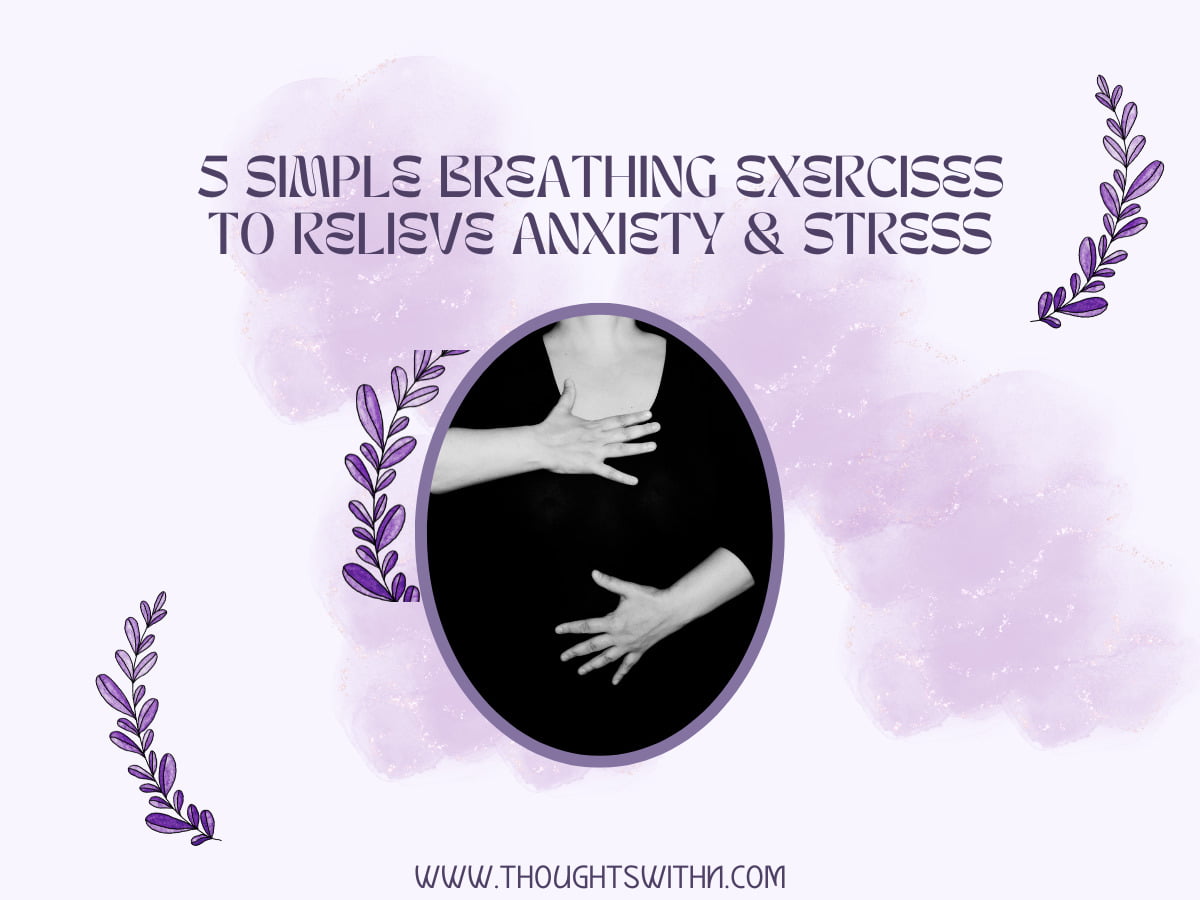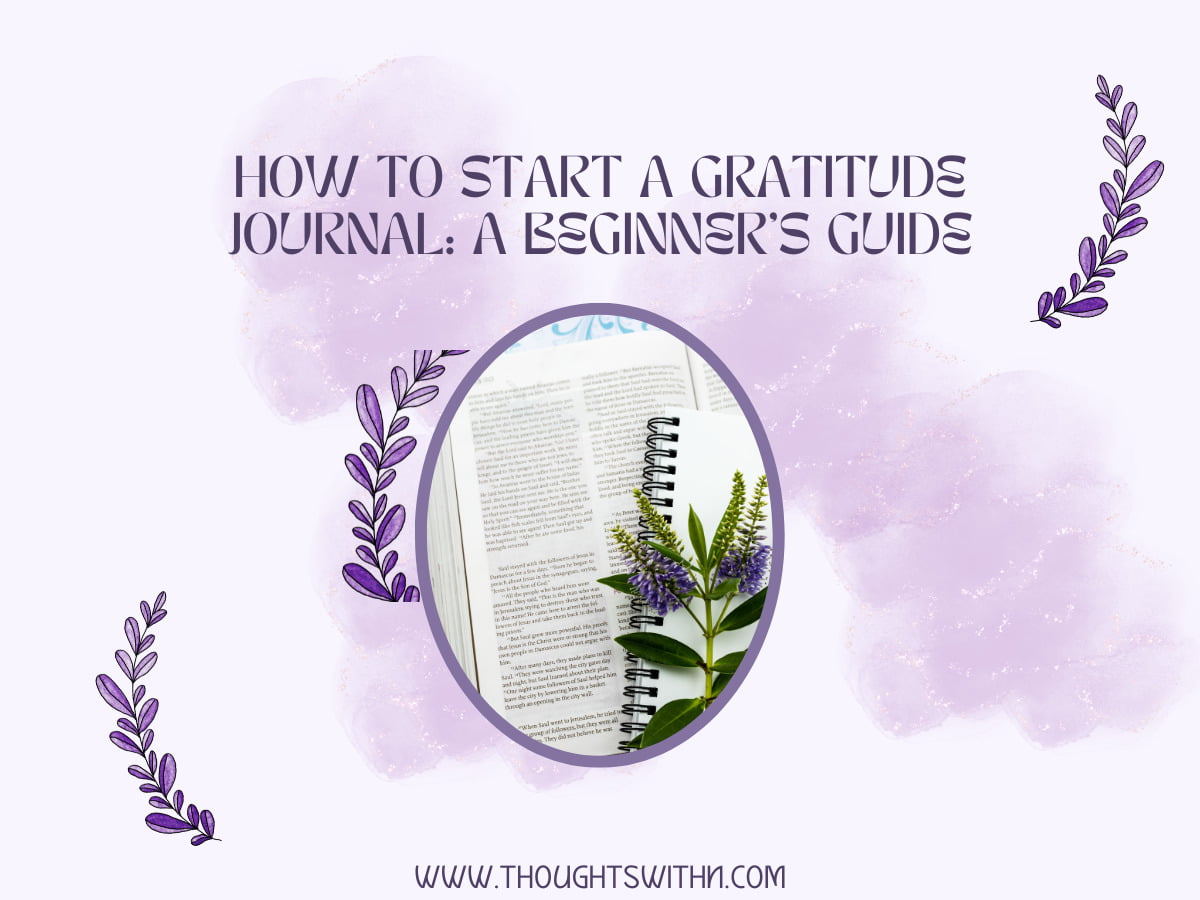Anxiety and stress can feel overwhelming, and sometimes it can be difficult to find relief. However, one of the most effective ways to combat these feelings is by practicing breathing exercises. Breathing exercises can help you to calm your mind, reduce muscle tension, and decrease your heart rate, all of which can help to ease anxiety and stress. In this article, we’ll explore five simple breathing exercises that you can do anywhere, anytime, to help you manage feelings of anxiety and stress. Whether you’re looking for a quick relaxation technique or a more long-term solution to anxiety, these breathing exercises are an excellent place to start. We’ll explore things like reading, starting a gratitude journal, breathing exercises, and other tips and tricks to keep your anxiety down and controllable. So, grab a notebook and prepare to jot down 5 simple breathing exercises to relieve anxiety & stress.
As I was sitting in that empty room back in December, it was clear that things needed to change. It was clear that my mental illness had tried to take me, and there I was, piecing together a coping plan.
What is generalized anxiety disorder?
I will give a quick rundown if you don`t know what that is. Generalized anxiety disorder is a feeling of ongoing stress and worries to the point where it can be all you feel. It starts to interfere with your regular day-to-day activities. It can present on its own or along with other mood/mental health struggles. It can make life quite difficult to manage through.
Generalized Anxiety Disorder (GAD) is a mental health condition characterized by excessive and persistent worry or anxiety about various issues. People with GAD may experience unrealistic or exaggerated worry and tension, even when there is little or no apparent reason for it. They may find it difficult to control their worrying and may worry about everything from small, everyday concerns to major life events. People with GAD may also experience physical symptoms such as muscle tension, fatigue, irritability, difficulty sleeping, and digestive issues. These symptoms can be persistent and can interfere with daily life and functioning. GAD is a common disorder, affecting around 3% of the population in any given year, and is often accompanied by other mental health conditions such as depression or other anxiety disorders. Treatment options for GAD include therapy, medication, or a combination of both, and can be highly effective in managing symptoms and improving the overall quality of life.
Symptoms of generalized anxiety disorder:
First, I`d like to point out that symptoms, mental illnesses, and conditions look different for everyone. Anxiety in one person likely presents itself differently in another person. The following are known common symptoms of generalized anxiety disorder but are in no way ALL the symptoms whatsoever.
- Overthinking
- Making plans to overcome WORSE-CASE scenarios
- Difficulty handling uncertainty
- Difficulty concentrating or having a blank mind when trying to focus
- Understanding situations to be very threatening even when they are not
- Headaches
- Muscle tension
- Sweating
- Fatigue
- Troubled sleeping
Again, these are just SOME of the symptoms. These are in no way ALL of them. I basically have every single one of these symptoms every single day. Life gets so discouraging when you are fighting these invisible things. On top of the anxiety disorder, I also have Bipolar 2 Disorder. A disorder that is not nearly known as much as BiPolar 1.
What is Bipolar 2 Disorder?
While BiPolar 2 is similar to BiPolar, there are differences very much worth noting. There are still the emotional highs and lows that one cycles through, though they may not be as intense. Struggling with BiPolar 2 Disorder encompasses long bouts of depression. Long, deep, and dark lows that seem to linger for what feels like forever.
Major Depressive Episode Symptoms:
A major depressive episode is characterized by symptoms that are so severe that they interrupt your day-to-day life and activities.
- Significant weight loss, with no diet or workout plan in place.
- Loss of interest in any hobbies/activities that were once enjoyed.
- Loss of energy.
- No motivation, or very little.
- Sleeping pattern change. Insomnia or sleeping all the time.
- Restlessness
The list, of course, continues. Again, symptoms are different and look different on everyone.
These two conditions kick my butt 90% of the time and leave me feeling a whole lot of nothing. So when I was sitting there in that empty room talking about what I would do the next time I had suicidal thoughts, it became very overwhelming. My mind went blank, and it felt like I couldn`t think. Though I was trying so hard. Slowly, surely, the doctor and I pieced together a mental health crisis plan that I could remember and found helpful. I became overwhelmed many times after leaving the hospital. I was shocked at what I had gone through for several days. This one breathing technique continued to ground me every single time.
Breathing exercises for anxiety
5 things you can see. Look around your environment and note 5 things you can see. It doesn`t matter what they are at all. You can say it in your head, making this a useful tool when you are out and bombarded with anxiety, or if you are at home, you can verbally say them.
4 things you can hear. This really forced me to quiet my mind so I could hear what was going on. My surroundings were no longer just NOISE but rather specific sounds.
3 things you can taste. Maybe it`s your coffee or your toothpaste, but whatever it is, be mindful and take note of it.
2 things you can smell. It may take some focusing to really clue in on what you are smelling, but take those moments to be present and breathe long, deep breaths in and out.
1 thing you can feel. Are you sitting on a soft blanket? Or maybe you are standing in line at the grocery store holding the grocery cart.
Sometimes I get the numbers mixed up, but the point of it is to re-focus your brain. Your mind can`t 100% focus on multiple things at once. So, if you can divert it, then you can bring it back to your calm. Then you have a better chance of regaining control over it. This breathing technique has brought me back from so many bad moments in the last two months now. It has brought me back to what my version of normal is. My normal changes daily, and I`m learning that that is perfectly okay.
But I return to this technique when I feel I can`t handle my feelings or lose control. It has helped me more than I can count in the last two months, and I am so grateful they taught it at the hospital.
Simple breathing techniques to relieve anxiety & stress:
- Diaphragmatic breathing – also known as belly breathing- involves breathing deeply from the diaphragm to promote relaxation and reduce tension.
- 4-7-8 breathing involves inhaling for four seconds, holding the breath for seven seconds, and exhaling slowly for eight seconds. It is said to help calm the nervous system and reduce anxiety.
- Box breathing – a technique used by Navy SEALs; box breathing involves inhaling for four seconds, holding the breath for four seconds, exhaling for four seconds, and holding for four seconds before repeating the cycle.
- Alternate nostril breathing involves breathing in through one nostril, holding the breath briefly, and then exhaling through the other nostril. It is said to promote balance and relaxation in the body.
- Equal breathing – also known as square breathing- involves inhaling and exhaling for the same length of time, such as inhaling for four seconds and exhaling for four seconds. It is said to promote relaxation and focus.
Do you have a go-to anxiety coping tool/technique?
Love Always, N
P.S. If you enjoyed this post, hop on over to my post talking about food and mental health!






I came across Herbal HealthPoint (w w w. herbalhealthpoint. c o m) two years ago and learnt about their successful COPD herbal therapy for COPD. I immediately started on the COPD treatment; few weeks into the treatment i began to notice a reduction in symptoms, after I completed the treatment, my symptoms were all gone including the severe shortness of breath, cough and wheezing. Its been over two years since treatment I feel better and breath better.
I often use this technique and it definitely works. I also use ‘box breathing’ where you breathe in, hold, breathe out, hold for equal counts. It’s amazing how much these simple tools can help ?
It is amazing. Thank you for sharing the box breathing technique with me! Sending love!
The breathing technique you mentioned is a good one, I do something similar. But just focus on certain points on my body. Toes, legs, arms, fingers, then maybe my senses. It’s a type of grounding. It doesn’t always help but it does sometimes. I have other coping mechanisms too. I suffer with depression and anxiety, and used to have selective mutism as a child. But I’m getting much better as time goes on. ? I’m sure you will too.
Thank you for sharing this.? Sending so much love your way.
My therapist told me that one too! Though I think she had said 5 of everything? ? anyway, the purpose is the same xD
First thing I do in a panic-indusing situation is first to hold my breath… which may not be the greatest idea ? I have no idea why I even do that (I guess that must be better than hyperventilate though?) then I actually breathe and talk to myself. I use this alot at work when we get use rushes out of nowhere, everybody knows by now and my manager give me some « almost done! Good job.. keep going » as encouragement here and there.
When I can and the panic come out of the blue at home, I just.. isolate, put on some music and try to shut off. My go to is mostly playing games, breathe, and just wait until it passes ??♀️
Thank you so much for sharing this with me!! ?
I love this concept! I often use yoga breathing techniques to wind down in the evening but 5,4,3,2,1 breathing sounds like a great way to re-focus on what is happening in the NOW.
Thank you!!? Sending love your way!
One of the best tricks I’ve learned is using my breath to either calm OR stimulate me. With Celiac Disease I often get fatigued and tired. Sometimes, what I need it rest: send myself to bed. Other times, it’s more mental and emotional. But breathwork also works wonders for that!
The ANS (autonomic nervous system) is amazing in this way:
inhale longer = stimulate the ANS = more awake (or anxious if you suffer anxiety)
exhale longer = relax the ANS = a little more tired and less anxious
So – I use breathwork – I can use to stimulate or to relax!
Thank you so much for sharing this!!?
This was a great read and great idea!
Thank you!
I think the 5,4,3,2,1 breathing technique you discuss is a great idea. It can certainly help in my classroom for many of my students. I will definitely have to try this out. Thanks!
Thank you so much for reading and commenting ?
You should also try headspace app, it’s great for meditation.
Oh thank you!! I will look into this!
Brilliant idea to suck you back into the present moment. Will have to remember it.
Thank you!!!
I have an anxiety disorder and OCD; my go to is basically to hug my cat. But if she’s not around then it’s to breathe and touch something near me. Like a wall or table. But sometimes remembering to do anything other than breathe can be really hard.
I can relate to that definitely. It’s hard. Good for you for having tools that you know work for you. Sending you so much love?
Breathing can help you in so many ways. I found myself having to take deep breaths when I am in stressful situations. They provide temporary relief from a mental health standpoint. Thanks for sharing all of these tips ♥
Nancy ♥ exquisitely.me
Thank you so much for your beautiful comment? sending so much love your way!
Love the 5 4 3 2 1. I think it could help anyone.
Thank you! Thanks for reading and commenting ?
Thank you!
First, did you recently re-do your blog header? Love how light and bright it looks!
Second, I had never heard of the 54321 breathing technique but I like how this seems to route you back to the present by helping you to focus on your surroundings. When I’m feeling anxious, I try to do measured deep breathing just to recenter myself but I’m going to have to give this new method a try!
Yes I did re-do my blog header and absolutely touched that you noticed!!!! Thank you! Thank you so much for sharing how you cope with anxiety. Sending love?
I absolutely love this technique! My therapist taught it to me when I was going through EMDR treatment and it helped me SO much! I’m so glad it’s helped you too. I have really bad anxiety as well as depression, so this been a life saver in some cases. And I didn’t know there was a Bipolar 2 disorder. I’m sorry you suffer from it, but thank you for educating me about it since I didn’t know that it existed. Thank you for such an inspiring post and sharing one of my favorite breathing techniques! <3
Emily | http://www.thatweirdgirllife.com
I’m so glad this technique helps you too. It’s made a very big difference in my life thankfully. Thank you so much for your meaningful comment?
This is such an important post as GAD is so important to raise awareness of in today’s modern society. I really believe your breathing technique will help a lot of other anxiety sufferers, so thank you very much for this post x
Thank you so much for your encouragement! Sending love!
That sounds like a great breathing method. I am glad that you found something that works for you!
Thanks so much for reading and commenting ?
I had never heard of this method before, I think its great. I struggle with anxiety as well, have all my life. With that comes depression as well. Typically breathing techniques don’t work for me, they make me focus too much on something that is happening within me and only increases my stress. That need to make it balance out and run smooth. I love this idea of moving through your senses though. I see great results from grounding myself and distracting my focus on something outside of myself. This process hits both those, definitely going to try it!
Thanks so much for this meaningful comment. I can definitely relate to how you feel. It’s hard to find techniques that balance out if you struggle with more than one obstacle, which I’m sure so many do. I hope this one helps you. Feel free to reach out if you ever need support or anything ?
Refocusing and focusing in on something intentional is so key! I’m glad you found a strategy that works for I you
Have you tried tapping? I gave it a shot one day when I was so anxious that my breathing exercises weren’t working, and I was having chest pain. Surprisingly to me, the practice helped even though it seemed silly when I first hard about it.
What is tapping? I have not tried it! I will research though. Thank you!!
My go to coping skill is literally stopping any and everything I am doing, close my eyes and tell myself it’s okay!
Yes!! That is fantastic!!